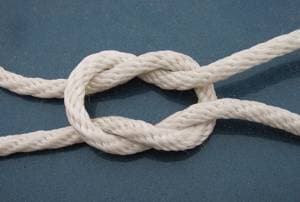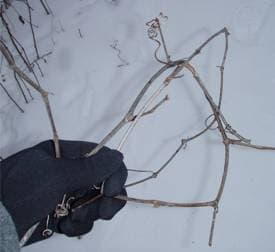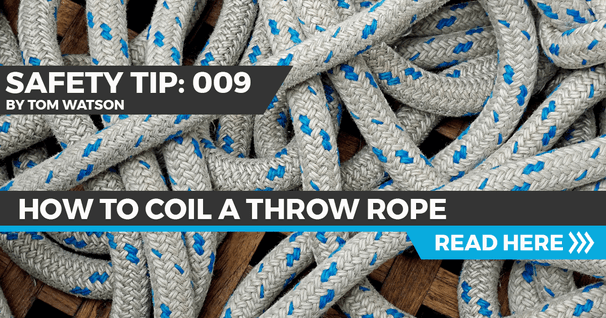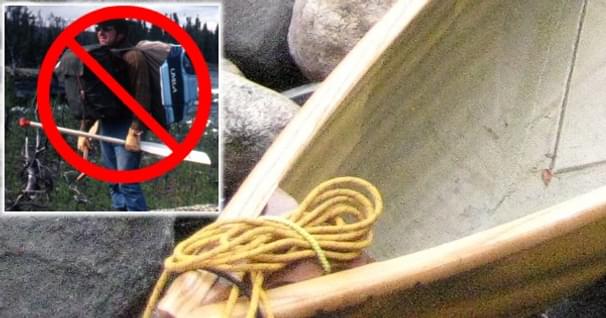At Rope’s End – And Beyond.
One of the most critical, and versatile pieces of kayaking gear is a workable length of line. Most kayaks have deck lines integrated into the design of the boat. In addition, many of us use a tie-line, secured off the bow that enables us to secure our boats when ashore or rigged with a Siwash anchor for a shallow bay mooring.

Of course, around camp the use of line is every bit as vital as at sea. There are guy lines, lashings, tie-downs, clothes lines and so forth. It’s a valuable length of equipment all right, but how you cope with the more critical uses of rope when you don’t have a length of it nearby?
There are several ways you can utilize materials to perform the duties of a length of rope. The most direct means is to find pieces of line already in use and promote them to a higher calling. Perhaps you can spare a shoe lace if means holding a tent flap together in a storm. You’ll have plenty of time to jerry-rig a new shoelace, but this will at least give you adequate protection from the storm. In fact, that quick-fix, probably a strip of clothing, stripped down to a workable width and length is another way to remedy a need for a line.

Today’s clothing, especially if seen as gear, affords the outdoors adventurer with many alternative options beyond apparel. A strip of cloth that includes the lower seam on a shirt can lace a boot, secure a bandage, temporarily fix a handle. Same goes for longer strips along the panels of a shirt that could be wound or braided together to form an adequate piece of cloth rope.
In more severe instances where tying or lashing are critical for survival, strips of any flexible material can be used for rope. Some materials don’t lend themselves to being tied into knots. In that case, clever folding and tucking one layer under another may be necessary. A prudent survivalist will know the limitations of his/her temporary "fix" so as not to introduce any more surprises into the existing situation. Oftentimes fixes are very temporary and must be repeated several times throughout the situation.
Most equipment these days, except the super, micro, mini gadgets have enough wiring in them to provide emergency line. You may not find as much rope as needed to make a secure lashing, but since wire is stronger, you may not need as many turns or wraps to gain a secure hold, either.
Consider, too, alternatives to the normal application. Who says a cross truss on a lashed lean-to can’t be held in place by the elastic loop of an inner tube? Gigantic camp ‘rubber bands’ are often used to secure lids, covers, gear in place. Simple headbands, wristlets, perhaps even belts could be made from elastic, perhaps freeing up that belt or a special need the elastic band couldn’t handle.
After all the options of utilizing gear and clothing have been spent there is still one vast resource to call upon for emergency roping – nature. Obviously threads and lines have been used for millennia to literally hold cultures together. Barks, vines and roots have long been used to create twines and lines for myriad uses.

Several plants are known to have fibrous parts that can be used to make rope. Cedar, Spruce, thistle, milkweed, cotton and nettle are just a few of the more common ones. I’ve made fishing line and lashing cordage out of nettle so can talk specifically about making line from this natural source.
Stinging nettle is both nasty and nice. It’s leaves "burn" victims with a hot sting from sap inside hollow hairs, yet it’s good to eat – sometimes called Roman spinach. Blanched leaves are quite edible. The stems, however, are strong and fibrous – just what we need for making rope.
Most rope made from natural fibers is comprised of at least three strands that are twisted tightly around each other, wound in a counter (Z) or clockwise (S) fashion. Individual fibers are arranged at intervals so shorter pieces can be woven together to form longer lengths. Mechanically, these fibers are processed and run through special heads that twist and wind the fibers first into strands and then into rope. The term "rope" general applies to a line at about one inch in circumference or about one half inch in diameter. For emergency needs we are actually creating "twine" – a term used for a length of fibers too narrow to be a rope and too thick to be thread.
When I made twine from nettles, I started with long stems that were stripped of side stems and leaves. I used a rock to carefully mash down the characteristic square stem (like the mint plant) breaking free the thin, long fibers I would use to weave into cord. A process called "retting" is used to make natural fibers into rope – the fibers are allowed to age and soften so they are more flexible. It’s a special skill to know when the fibers are ready because retting also makes the fibers weaker with age.
I used the nettle fibers as they came from the stem. I gathered 12-15 strands of fibers together, tied one end off and draped it over a hook. Next, I divided the bundle into three equal bundlettes and began a basic braided weave. I kept adding a few fibers to each bundlette as I moved down the line. Within about twenty minutes I had a stout length of braided cordage about five feet long.
This was a hasty attempt at making rope but from this demonstration I found how easy it was to produce rope from raw resources. I actually made enough to produce a hand fishing line but never caught any fish. The cord I did make was easily strong enough to lash together an emergency lean-to later that day. I kept a coiled, six foot section of the nettle rope in my car and the cord lasted at least three days in the summer before it dried out and became brittle.
It’s usually not too hard to find a substitute for rope. Large sections can be reduced by unraveling, fish nets can be cut apart to create long lines, even vines can be utilized to help set up a camp (simple lashings, stringers to keep grass from blowing away, and more). Having a little "McGyver" in reserve will help you fashion lines from an amazing list of resources.
Tom Watson is an avid sea kayaker and freelance writer. He also posts articles and thoughts on his website www.wavetameradventures.com. He has written 2 books, "Kids Gone Paddlin" and "How to Think Like A Survivor" that are available on Amazon.com.
Related Articles
This a follow up to a video I did where I talked about differences that you may find in dry and semi-dry…
Throw ropes are a critically important “life line” in certain rescue situations where approaching…
In Kurasawa’s classic film Dersu Usala, the two principle characters, Usala, the Mongolian guide…
In the mid-seventies, I shared an afternoon with the famous woodsman, Calvin Rutstrum, whose flagship…



